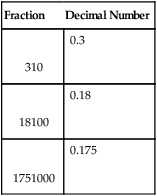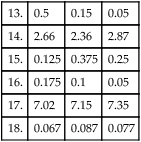CHAPTER 3 After reviewing this chapter, you should be able to: 3. Compare the size of decimals 4. Convert fractions to decimals 5. Convert decimals to fractions 10. Round decimals to the nearest tenth The easiest way to understand decimals is to memorize the place values (Box 3-1). The first place to the right of the decimal is tenths. The second place to the right of the decimal is hundredths. The third place to the right of the decimal is thousandths. The fourth place to the right of the decimal is ten-thousandths. Because the last zero does not change the value of the decimal, it is not necessary. The preferred notation, as in the example shown on p. 23, is 0.37 mg, not 0.370 mg, and 30, not 30.0, which could be interpreted as 370 and 300, respectively, if the decimal point is not clear or is missed.
Decimals
Example 2:
READING AND WRITING DECIMALS
Example:







 Practice Problems
Practice Problems Practice Problems
Practice Problems



